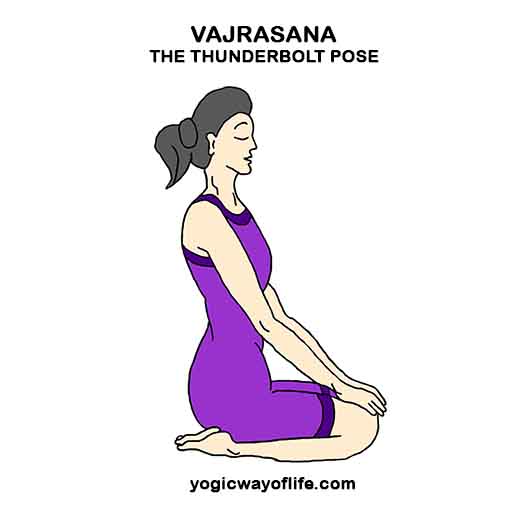Vajrasana or the kneeling yoga pose is also called the diamond pose or the thunderbolt pose. In Sanskrit, Vajra means thunderbolt or diamond and Asana means a pose. Vajrasana is a sitting posture and can be used for meditation and prayer.
Normally, Asanas should be performed on an empty stomach. But, Vajrasana is one of the few exceptions. This asana can be done immediately after the meal. In fact, Vajrasana is most effective after the meal and aids in proper digestion.
How to do Vajrasana (The Thunderbolt Pose)?
- Vajrasana is a sitting posture. To start, stand on the knees with the lower legs together and stretched backwards, the two big toes crossing each other.
- Lower your body and sit on your heels. Your buttocks will be resting on the heels and the thighs on the calf muscles.
- Keep your hands on your knees and keep the head straight.
- Concentrate on the breath and observe the process of inhalation and exhalation.
- One may close the eyes, to get good concentration and to calm the mind.
- Remain in this position for at least 5 – 10 minutes. In the initial stages, there may be pain in the legs when you sit in this position. When that happens, release the asana and stretch your legs. Massage the ankles, knees and calf muscles with your hand. With practice one can go up to 30 minutes or more in this position.
Benefits of Vajrasana (The thunderbolt Pose)
- Vajrasana modifies the blood flow in the lower pelvic region. It reduces blood flow to the legs and increases the blood flow to the digestive organs. This increases the efficiency of the digestive system and helps those with weak digestion to digest a full meal easily.
- It helps to prevent acidity and ulcers by improving the digestion.
- It is a good meditative pose for those suffering from sciatica and severe lower back problems.
- Slow and rhythmic breathing in Vajrasana can induce a meditative state.
Contraindications for Vajrasana (Thunderbolt Pose)
- Those suffering from severe knee pain should not practice Vajrasana.
- Those who had any recent surgery of legs or waist should avoid this asana.
- If you feel any pain in the ankles, release the pose and massage the ankle with your hands.
- Pregnant women should try this asana only with their knees apart in order to avoid stress on the abdomen.

